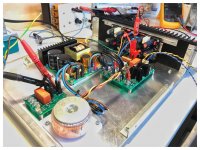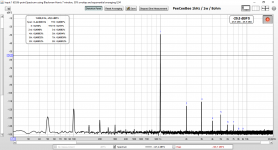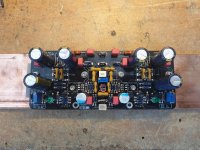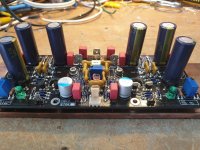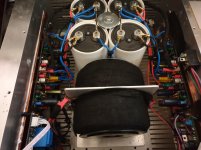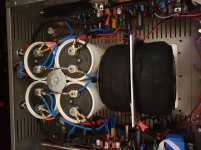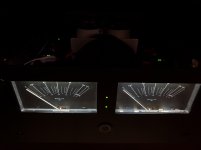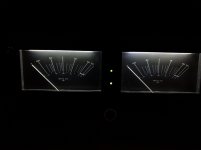Some progress...
Measured output power today: 1khz into 8 ohms: 140,28 watt just before clipping. This is with an SMPS with dual 55 volt rails.
 🙂
🙂Hi Shaan, I measured the distortion of my PeeCeeBee and get the attached result. It seems worse that your measurements.
I guess that the distortion present in source signal is important too because these will get amplified as well (I guess). The distortion present in the source signal and measuring device (Focusrit 2i2) is listed in post #103 of this thread: https://www.diyaudio.com/forums/sol...stortion-measurements-rew-11.html#post5832476
Would you consider my results as being normal?
I guess that the distortion present in source signal is important too because these will get amplified as well (I guess). The distortion present in the source signal and measuring device (Focusrit 2i2) is listed in post #103 of this thread: https://www.diyaudio.com/forums/sol...stortion-measurements-rew-11.html#post5832476
Would you consider my results as being normal?
Attachments
Wow indeed it looks considerably worse. Can you post a snapshot of source THD?
During my tests when I fed the amp from PC's line-out I got a similar result as yours. Turned out the PC's line-out had a lot of THD of its own and also the loop through ground conductor was catching a lot of low frequency noise. So I played the test tone from my phone and filtered it through an 8th order low-pass filter that brought source THD down to 0.001%. With this signal I got consistent measurements and also this procedure removed the 100Hz hum and associated harmonics due to elimination of ground loop between the PC and amp.
Reducing Distortion of Dirty 1KHz Sinewave With Active Lowpass Fiter - Doable?
During my tests when I fed the amp from PC's line-out I got a similar result as yours. Turned out the PC's line-out had a lot of THD of its own and also the loop through ground conductor was catching a lot of low frequency noise. So I played the test tone from my phone and filtered it through an 8th order low-pass filter that brought source THD down to 0.001%. With this signal I got consistent measurements and also this procedure removed the 100Hz hum and associated harmonics due to elimination of ground loop between the PC and amp.
Reducing Distortion of Dirty 1KHz Sinewave With Active Lowpass Fiter - Doable?
Last edited:
Wow indeed it looks considerably worse. Can you post a snapshot of source THD?
During my tests when I fed the amp from PC's line-out I got a similar result as yours. Turned out the PC's line-out had a lot of THD of its own and also the loop through ground conductor was catching a lot of low frequency noise. So I played the test tone from my phone and filtered it through an 8th order low-pass filter that brought source THD down to 0.001%. With this signal I got consistent measurements and also this procedure removed the 100Hz hum and associated harmonics due to elimination of ground loop between the PC and amp.
Reducing Distortion of Dirty 1KHz Sinewave With Active Lowpass Fiter - Doable?
I'm using a Focusrite 2i2 audio interface to measure THD. It's not the PC's sound card. In the link I posted above (CLICK HERE) you'll see the plot for a loop back test. The 1kHz test signal is generated by REW. Output 1 on my Focusrite interface is fed back to the input; this results in a THD of 0,0012%.
With the above as my source, which is quite good, I still measure a THD of 0,0097% (at 1 watt output into 8 ohms).
I will try to use a separate signal generator to eliminate possible ground loops.
Last edited:
Almost done....
What happened to R35 - R38? It's not clear in the pictures what you did there but it looks like you've used a wire?
I believe even if you use matched mosfets it is good to have some resistance there. Of course, ask Shaan. I would use those 5w resistors.
Shaan said that i can use short wire.The amp is very very stable so far.
Thank you for your interest.
Thank you for your interest.
Except for the heatsink mounted devices, is it necessary to solder on the silkscreen side of the PCB (too)? Or, is this personal preference? I've never seen that before.Almost done....
If you don't , you will see some pads with some solder on top and some pads without solder on top , I think it does not look so good like that.
V4H
Just finished.....


2 x 500VA trafos
4 x 47000uf KEMET caps
silver mica caps
2200uf organic aluminum polymer(very fast and good sounding caps)
Vishay dale CMF55 resistors
Copper plates for better heat dissipation and EMI shield
Fan system(activates at 45 degrees Celsius)
Duelund cables for input and speakers(my favorite cables)
Soft start
ETI RESEARCH rca sockets and AUDIO NOTE speaker bidding posts
Huge ONKYO type VU meters 130mm x 80mm
BIAS at 400ma(lot of heat)
The sound is AMAZING



Just finished.....



2 x 500VA trafos
4 x 47000uf KEMET caps
silver mica caps
2200uf organic aluminum polymer(very fast and good sounding caps)
Vishay dale CMF55 resistors
Copper plates for better heat dissipation and EMI shield
Fan system(activates at 45 degrees Celsius)
Duelund cables for input and speakers(my favorite cables)
Soft start
ETI RESEARCH rca sockets and AUDIO NOTE speaker bidding posts
Huge ONKYO type VU meters 130mm x 80mm
BIAS at 400ma(lot of heat)
The sound is AMAZING




Attachments
- Home
- Group Buys
- PeeCeeBee V4H GB
